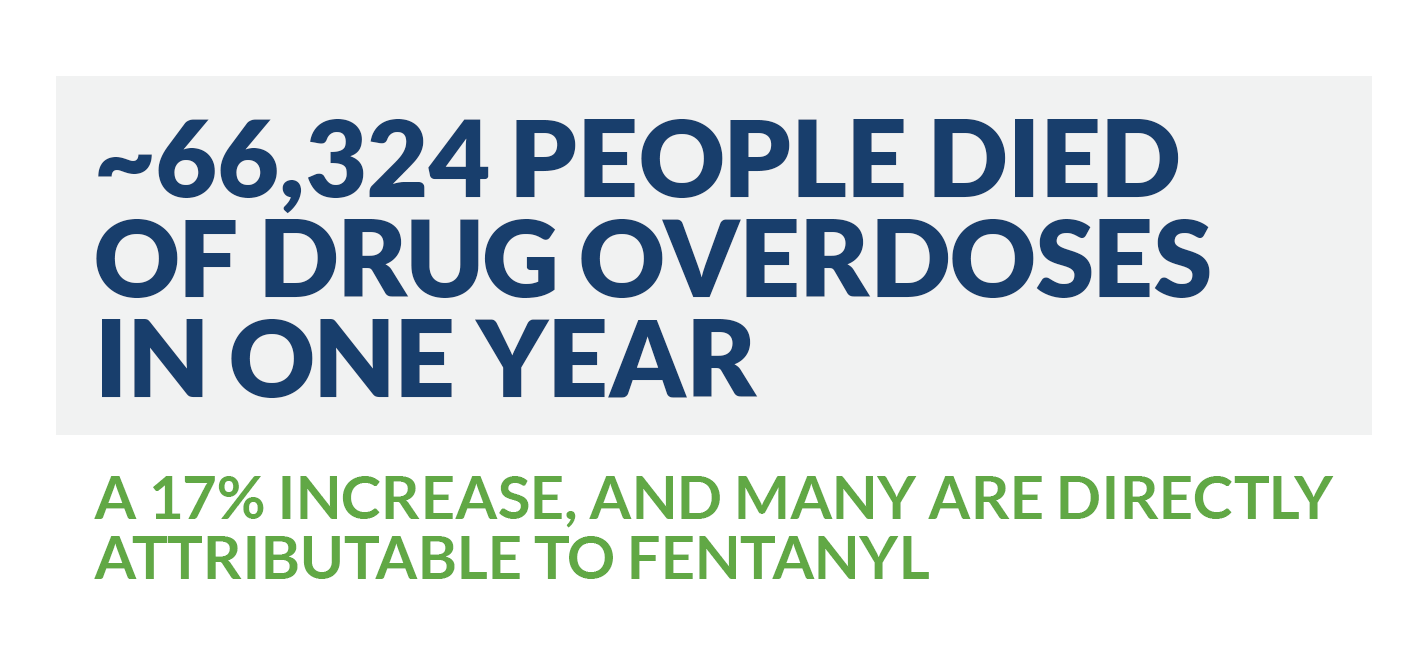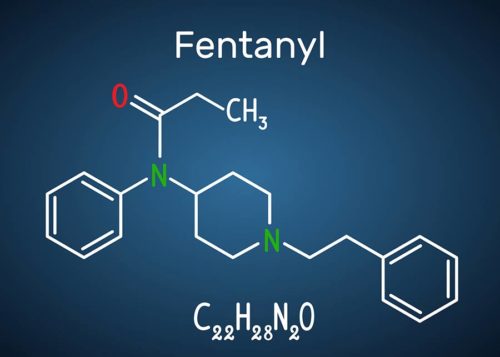Fentanyl Addiction and Abuse Statistics
Fentanyl addiction is a national health concern of serious import that has racked up an alarming death toll— especially in the northeastern United States where it is considered an emerging public enemy. Even conservative estimates rate fentanyl as 50-100 times more potent than morphine, adding to the scientifically established dangers associated with the drug. Although fentanyl continues to be prescribed in legitimate pharmaceutical varieties for pain management, illicit versions of the drug smuggled from China through the US postal service and Mexican drug cartels are responsible for fueling an epidemic of overdoses, crime, and death. A major part of the problem lies in fentanyl’s chemical composition, which lends itself to easy reproduction by street chemists and cost-effective mixture with other popular drugs and common household ingredients.
BRAND NAMES AND COMMON FORMS
When prescribed for legitimate medical purposes, fentanyl comes in a variety of forms including lollipops, tablets, lozenges, transdermal patches, and intravenous injections. Unfortunately, these same forms appear on a highly profitable black market that supplies smugglers, dealers and recreational users. Fentanyl is also pedaled on the street as a fine, white powder that may be absorbed orally, smoked, injected, or snorted.
Prescription-grade fentanyl, usually reserved for moderate to severe pain management, is sold under popular brand names such as Sublimaze, Actiq and Duragesic. Street-savvy slang names for fentanyl, which is often laced with heroin and other illicit synthetic drugs, include:
- Jackpot
- Apache
- Tango and Cash
- Murder 8
- China Girl
- Goodfella
- TNT
- Dance fever
Although all forms of illicit fentanyl are profitable for dealers, a niche black market is focused exclusively on the transdermal patch—which provides maximum euphoria to users in short durations. Even after singular use, people caught in the early grips of fentanyl dependence are willing to pay exorbitant prices for the patch, and many are willing to go to any extreme to obtain more after developing full-blown addiction. Fentanyl lollipops are equally, if not more, problematic. Fentanyl lollipops are a sweet tasting version of the prescription drug Actiq that is usually prescribed to cancer patients age 16 or older who are already opiate-tolerant. Like the transdermal patch, fentanyl lollipops are highly addictive and devastating to psychological and physiological health. Unlike the transdermal patch, however, they have developed a glamorized, Hollywood appeal and frequently cause oral infections, tooth loss and decay, and painful cavities.
OPIATE AND FENTANYL ABUSE STATISTICS

Although state, local and federal authorities continue to assign blame for the national fentanyl epidemic on a diversity of factors, the single greatest reason is the predatory marketing tactics of major pharmaceutical companies in the 1990s. Propelled by a desire to achieve astronomical profits and backed by powerful political lobbies and special interest groups, they repeatedly lied to the American public about the “minimal dangers” associated with opiates, downplaying the deadly potency of fentanyl through slick marketing campaigns and unethical medical practices.
THE NORTHEAST EPIDEMIC
At the epicenter of the national fentanyl crisis is the entire state of New Hampshire and Long Island, New York— locations often grimly referred to as “ground zero. The CDC listed New Hampshire as having one of the highest drug overdose death rates in the nation over the past two years. The following statistics provide a brief summary:
- In 2016, New Hampshire saw an overdose death rate of approximately 40 people per 100,000, a 34 percent increase from the previous year.
- Despite maximum efforts by authorities to control the fentanyl epidemic, the state is expected to close out 2018 with approximately 470 overdose deaths— many the direct result of fentanyl or fentanyl-laced heroin or cocaine.
- The fentanyl epidemic has prompted state congressional members to seek emergency funding in order to combat the crisis.
Long Island, New York is also in dire condition, with fentanyl-related deaths rapidly outpacing those attributable to heroin and showing little to no signs of stopping, making it the undisputed kingpin in an already heavily saturated, opiate-fueled drug culture. The Nassau and Suffolk county Medical Examiner’s office reported:
- Approximately 500 people died in 2016 as a result of opiate overdoses— many the result of fentanyl or other synthetically laced opiates.
- 303 people died in Suffolk County specifically, and 190 in Nassau County, a disturbing trend by any measure.
According to Suffolk County Medical Examiner Dr. Michael J. Caplan, “Fentanyl has surpassed heroin as the most commonly detected drug in fatal opioid overdoses.” Dr. Caplan also added, “The influx of illicitly manufactured fentanyl from overseas is a nationwide issue that requires a multidisciplinary intervention from all levels of government.” As these statistics clearly indicate, fentanyl is devastating the northeast United States, overwhelming the coroner’s office, flooding the criminal justice system, and turning hospital emergency rooms into revolving doors for fentanyl-crazed or overdosed patients.
SEEKING HELP
If you or someone you love is struggling with fentanyl addiction, consult a substance abuse professional today. Fentanyl is a killer that knows no social, professional, economic, religious, or racial boundaries. It can affect anyone, at any time, regardless of whether or not there is a known genetic proclivity for addiction or history of prior use.
Also remember, fentanyl overdose is a medical emergency requiring immediate treatment at a hospital emergency room. Don’t delay, act now!
For more about fentanyl addiction and recovery check out these related articles:
- Fentanyl Detox–Withdrawal Symptoms and Timeline
- Fentanyl Addiction: Signs and Symptoms of Fentanyl Abuse
- Key Elements of Relapse Prevention
- What Does a Day in Rehab Look Like?
Sources:
Harm Reduction Journal. Fentanyl-contaminated drugs and non-fatal overdose among people who inject drugs in Baltimore, MD. Feb, 2018.
National Institute on Drug Abuse. New Hampshire Opioid Summary. Feb, 2018.
National Institute on Drug Abuse. New Jersey Opioid Summary. Feb, 2018.
Long Island Pulse. The Spiral into Fentanyl. June, 2017.

